Cylinder Head (W/ Glow Plug Controller) -- Inspection |
| 1. CLEAN CYLINDER HEAD SUB-ASSEMBLY |
Using a gasket scraper, remove all the gasket material from the surface of the cylinder head that contacts the cylinder block.
- NOTICE:
- Be careful not to scratch the surface of the cylinder head.
Using a soft brush and solvent, thoroughly clean the cylinder head.
Using a valve guide bushing brush and solvent, clean all the guide bushes.
 |
| 2. INSPECT CYLINDER HEAD SUB-ASSEMBLY |
Inspect the cylinder head for warpage.
Using a precision straightedge and feeler gauge, measure the surfaces of the cylinder head that contact the cylinder block and manifolds for warpage.
- Maximum warpage:
- 0.15 mm (0.00591 in.)
If the warpage is more than the maximum, replace the cylinder head sub-assembly.Text in Illustration *a Cylinder Block Side *b Intake Manifold Side *c Exhaust Manifold Side
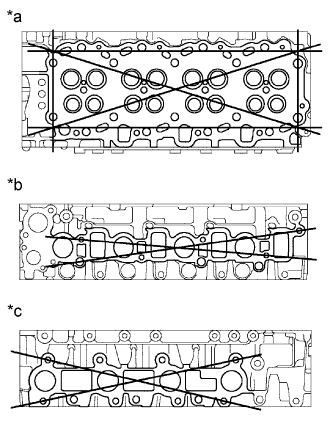 |
Inspect the cylinder head for cracks.
Using a dye penetrant, check the combustion chamber, intake ports, exhaust ports and cylinder block surface for cracks.
If there are cracks, replace the cylinder head sub-assembly.
| 3. CLEAN INTAKE VALVE |
Using a gasket scraper, chip off any carbon from the valve head.
Using a wire brush, thoroughly clean the valve.
| 4. INSPECT INTAKE VALVE |
Using a micrometer, measure the diameter of the valve stem.
- Standard valve stem diameter:
- 5.970 to 5.985 mm (0.235 to 0.236 in.)
Check the valve face angle.
Grind the valve enough to remove any pits and carbon.
Check that the valve is ground to the correct valve face angle.
- Standard valve face angle:
- 44.5°
If the result is not as specified, replace the valve.Text in Illustration *1 Valve Face Angle
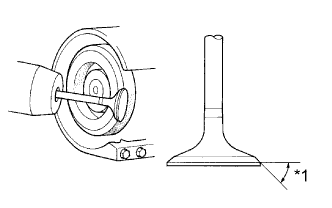 |
Check the valve head margin thickness.
- Standard margin thickness:
- 1.1 mm (0.0433 in.)
- Minimum margin thickness:
- 0.8 mm (0.0315 in.)
If the margin thickness is less than the minimum, replace the intake valve.Text in Illustration *1 Margin Thickness
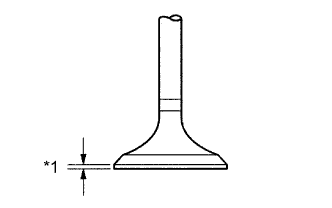 |
Check the overall valve length.
- Standard overall length:
- 105.15 to 105.75 mm (4.14 to 4.16 in.)
- Minimum overall length:
- 104.65 mm (4.12 in.)
Check the surface of the valve stem tip for wear.
If the valve stem tip is worn, resurface the tip with a grinder or replace the intake valve.- NOTICE:
- Do not grind the valve so it becomes shorter than the minimum overall length.
 |
| 5. CLEAN EXHAUST VALVE |
Using a gasket scraper, chip off any carbon from the valve head.
Using a wire brush, thoroughly clean the exhaust valve.
| 6. INSPECT EXHAUST VALVE |
Using a micrometer, measure the diameter of the valve stem.
- Standard valve stem diameter:
- 5.960 to 5.975 mm (0.2346 to 0.2352 in.)
Check the valve face angle.
Grind the valve enough to remove any pits and carbon.
Check that the valve is ground to the correct valve face angle.
- Standard valve face angle:
- 44.5°
If the result is not as specified, replace the exhaust valve.Text in Illustration *1 Valve Face Angle
 |
Check the valve head margin thickness.
- Standard margin thickness:
- 1.2 mm (0.0472 in.)
- Minimum margin thickness:
- 0.7 mm (0.0276 in.)
If the margin thickness is less than the minimum, replace the valve.Text in Illustration *1 Margin Thickness
 |
Check the overall valve length.
- Standard overall length:
- 105.02 to 105.62 mm (4.13 to 4.16 in.)
- Minimum overall length:
- 104.52 mm (4.11 in.)
Check the surface of the valve stem tip for wear.
If the valve stem tip is worn, resurface the tip with a grinder or replace the exhaust valve.- NOTICE:
- Do not grind the valve so it becomes shorter than the minimum overall length.
 |
| 7. INSPECT INNER COMPRESSION SPRING |
Using a steel square, measure the deviation of the spring.
- Maximum deviation:
- 2.0 mm (0.0787 in.)
If the deviation is more than the maximum, replace the inner compression spring.Text in Illustration *1 Deviation
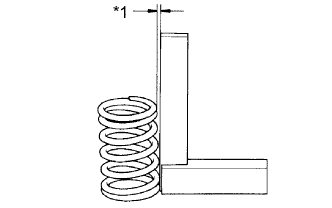 |
Using a vernier caliper, measure the free length of the spring.
- Standard free length:
- 48.4 mm (1.91 in.)
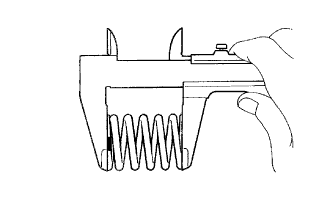 |
Using a spring tester, measure the tension of the valve spring at the specified installed length.
- Standard tension (at 33.1 mm (1.30 in.)):
- 175 to 193 N (18 to 19 kgf, 39.4 to 43.3 lbf)
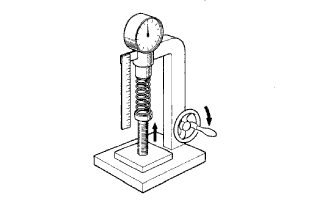 |
| 8. INSPECT INTAKE VALVE GUIDE BUSH |
Using a caliper gauge, measure the inside diameter of the valve guide bush.
- Standard valve guide bush inside diameter:
- 6.01 to 6.03 mm (0.2366 to 0.2374 in.)
 |
Subtract the valve stem diameter measurement (refer to the intake valve inspection procedures above) from the valve guide bush inside diameter measurement.
- Standard oil clearance:
- 0.025 to 0.060 mm (0.000986 to 0.00236 in.)
- Maximum oil clearance:
- 0.08 mm (0.00315 in.)
| 9. INSPECT EXHAUST VALVE GUIDE BUSH |
Using a caliper gauge, measure the inside diameter of the valve guide bush.
- Standard valve guide bush inside diameter:
- 6.01 to 6.03 mm (0.2366 to 0.2374 in.)
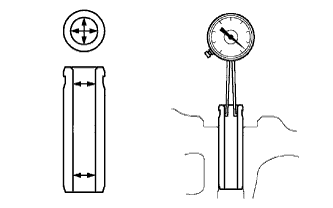 |
Subtract the valve stem diameter measurement (refer to the exhaust valve inspection procedures above) from the valve guide bush inside diameter measurement.
- Standard oil clearance:
- 0.035 to 0.070 mm (0.00138 to 0.00276 in.)
- Maximum oil clearance:
- 0.10 mm (0.00394 in.)
| 10. INSPECT INTAKE VALVE SEAT |
Using a 45° carbide cutter, resurface the valve seats. Remove only enough metal to clean the valve seats.
Text in Illustration *1 45° Carbide Cutter
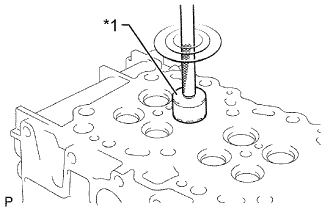 |
Apply a light coat of Prussian blue to the valve face.
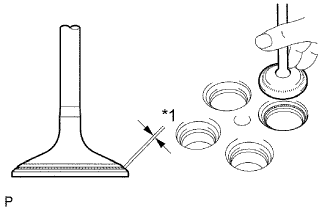 |
Lightly press the valve face against the valve seat.
- NOTICE:
- Do not rotate the valve while pressing the valve against the valve seat.
Check the valve face and valve seat.
Check that the contact surfaces of the valve seat and valve face are in the middle area of their respective surfaces, with the width between 1.2 and 1.6 mm (0.0472 and 0.0630 in.).
If the contact surfaces are not as specified, resurface the valve intake seat. If necessary, replace the intake valve.Text in Illustration *1 Width Check that the contact surfaces of the valve seat and valve face are even around the entire valve seat.
If the contact surfaces are not as specified, resurface the intake valve seat. If necessary, replace the intake valve.
| 11. INSPECT EXHAUST VALVE SEAT |
Using a 45° carbide cutter, resurface the valve seats. Remove only enough metal to clean the valve seats.
Text in Illustration *1 45° Carbide Cutter
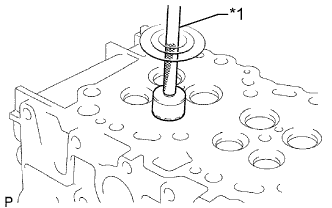 |
Apply a light coat of Prussian blue to the valve face.
 |
Lightly press the valve face against the valve seat.
- NOTICE:
- Do not rotate the valve while pressing the valve against the valve seat.
Check the valve face and valve seat.
Check that the contact surfaces of the valve seat and valve face are in the middle area of their respective surfaces, with the width between 1.6 and 2.0 mm (0.0630 and 0.0787 in.)
If the contact surfaces are not as specified, resurface the exhaust valve seat. If necessary, replace the exhaust valve.Text in Illustration *1 Width Check that the contact surfaces of the valve seat and valve face are even around the entire valve seat.
If the contact surfaces are not as specified, resurface the exhaust valve seat. If necessary, replace the exhaust valve.
| 12. INSPECT VALVE LIFTER |
Using a micrometer, measure the lifter diameter.
- Standard lifter diameter:
- 30.966 to 30.976 mm (1.219 to 1.220 in.)
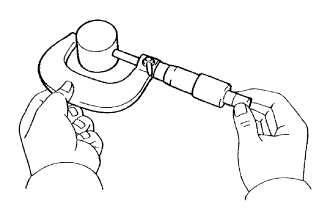 |
Using a caliper gauge, measure the lifter bore diameter of the cylinder head.
- Standard lifter bore diameter:
- 31.000 to 31.021 mm (1.220 to 1.221 in.)
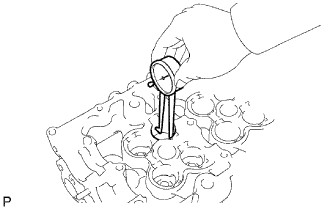 |
Measure the oil clearance by subtracting the lifter diameter measurement from the lifter bore diameter measurement.
- Standard oil clearance:
- 0.024 to 0.055 mm (0.000945 to 0.00217 in.)
- Maximum oil clearance:
- 0.095 mm (0.00374 in.)
| 13. INSPECT CAMSHAFT OIL CLEARANCE |
Clean the bearing caps and journals.
Check the bearings for flaking and scoring.
If the bearings are damaged, replace the bearing caps and cylinder head as a set.
Place the camshaft on the cylinder head.
Lay a strip of Plastigage across each of the journals.
Text in Illustration *1 Plastigage *a Intake Side *b Exhaust Side
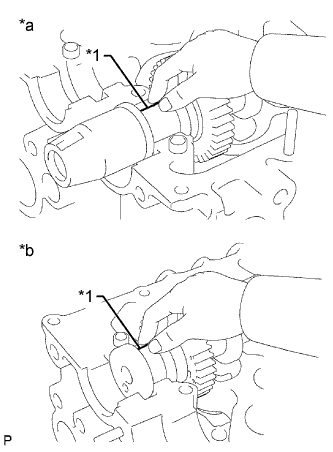 |
Install the bearing caps.
- NOTICE:
- Do not turn the camshaft.
Remove the bearing caps.
Measure the Plastigage at its widest point.
- Standard oil clearance:
- 0.025 to 0.062 mm (0.000984 to 0.00244 in.)
- Maximum oil clearance:
- 0.1 mm (0.00394 in.)
If the oil clearance is more than the maximum, replace the camshaft. If necessary, replace the bearing caps and cylinder head as a set.Text in Illustration *1 Plastigage *a Intake Side *b Exhaust Side
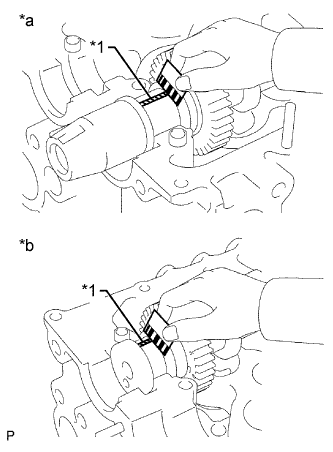 |
Completely remove the Plastigage.
Remove the camshaft.
| 14. INSPECT CAMSHAFT THRUST CLEARANCE |
Install the camshaft.
Using a dial indicator, measure the thrust clearance while moving the camshaft back and forth.
- Standard thrust clearance:
- 0.035 to 0.185 mm (0.00138 to 0.0728 in.)
- Maximum thrust clearance:
- 0.25 mm (0.00984 in.)
If the thrust clearance is more than the maximum, replace the camshaft. If necessary, replace the bearing caps and cylinder head as a set.Text in Illustration *a Intake Side *b Exhaust Side
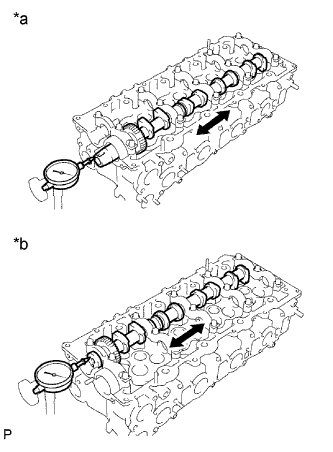 |
Remove the camshaft.